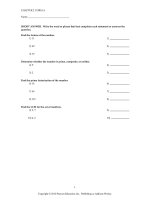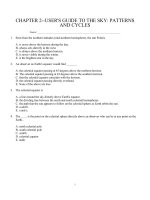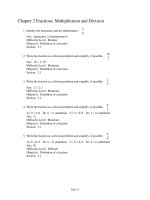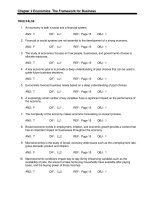Introductory statistics 2nd edition gould test bank
Bạn đang xem bản rút gọn của tài liệu. Xem và tải ngay bản đầy đủ của tài liệu tại đây (921.69 KB, 43 trang )
MULTIPLE CHOICE. Choose the one alternative that best completes the statement or answers the question.
A fitness instructor measured the heart rates of the participants in a yoga class at the conclusion of the class. The data is
summarized in the histogram below. There were fifteen people who participated in the class between the ages of 25
and 45. Use the histogram to answer the question.
1) How many participants had a heart rate between 120 and 130 bpm?
A) 3
B) 4
C) 5
D) 2
2) How many participants had a heart rate between 140 and 150 bpm?
A) 4
B) 3
C) 5
D) 2
3) What percentage of the participants had a heart rate greater than 130 bpm?
A) 53%
B) 13%
C) 33%
1)
2)
3)
D) 27%
4) What is the approximate percentage of participants that had a heart rate less than 130 bpm?
A) 47%
B) 13%
C) 33%
D) 53%
Solve the problem.
5) Each day for twenty days a record store owner counts the number of customers who purchase an
album by a certain artist. The data and a dotplot of the data are shown below:
Data set: 1, 3, 4, 4, 5, 6, 7, 2, 3, 4, 4, 5, 6, 8, 2, 3, 4, 5, 6, 7, 9
Which of the following statements can be made using the given information?
A) On the first day of collecting data the record store owner had one person purchase an album
by the artist.
B) During the twenty days when the record store owner collected data, there were some days
when no one purchased an album by the artist.
C) The dotplot shows that this data has a roughly bell-shaped distribution.
D) None of these
1
4)
5)
6) For twenty days a record store owner counts the number of customers who purchase an album by a 6)
certain artist. The data and a dotplot of the data are shown below:
Data set: 1, 3, 4, 4, 5, 6, 7, 2, 3, 4, 4, 5, 6, 8, 2, 3, 4, 5, 6, 7, 9
Which of the following statements can be made using the given information?
A) The dotplot shows that this data has a roughly bell-shaped distribution.
B) On five of the twenty days observed by the record store owner, there were four albums by
the artist purchased.
C) During the twenty days when the record store owner collected data, at least one album by
the artist was purchased each day.
D) All of these
7) The histogram below shows the distribution of pass rates on a swimming test of all children who
completed a four week summer swim course at the local YMCA. How many of the courses had a
pass rate less than 40 percent?
A) Not enough information available
C) About 3
B) About 8
D) About 5
2
7)
8) The histogram below shows the distribution of pass rates on a swimming test taken by all children
who completed a four week summer swim course at the local YMCA. What is the typical pass rate
for the swim test?
A) Not enough information available
C) About 55%
8)
B) About 95%
D) About 75%
9) Based on the histogram below, would it be unusual to be on hold for 5 minutes or more at this call
center?
A) No, it would not be unusual.
B) Yes, it would be unusual.
C) Not enough information given.
3
9)
10) A dot plot of the speeds of a sample of 50 cars passing a policeman with a radar gun is shown
below.
10)
What proportion of the motorists were driving above the posted speed limit of 65 miles per hour?
A) 0.02
B) 0.08
C) 1
D) 0.10
Provide an appropriate response.
11)
11)
How many people were 26 years old?
A) 5
B) 1
C) 0
4
D) 3
12)
12)
How many people were 23 years old or older?
A) 3 people
B) 12 people
C) 8 people
Solve the problem.
13) In the following histogram, what can you conclude about the bin width?
A) The bin width is too small. We are hiding details of the distribution.
B) The bin width is too large. We are hiding details of the distribution.
C) The bin width is too large. We are given too much detail.
D) The bin width is too small. We are given too much detail.
5
D) 10 people
13)
14) In the following histogram, what can you conclude about the bin width?
A) The bin width is too large. We are given too much detail.
B) The bin width is too small. We are hiding details of the distribution.
C) The bin width is too small. We are given too much detail.
D) The bin width is too large. We are hiding details of the distribution.
6
14)
15) Which histogram represents the same data as the dotplot shown below?
A)
B)
C)
D)
7
15)
16) Which dotplot represents the same data as the histogram shown below?
A)
B)
C)
D)
8
16)
17) The following histogram represents audience movie ratings (on a scale of 1-100) of 489 movies.
What is the typical movie rating given by audiences according to this distribution?
A) The typical value is about 70.
C) The typical value is about 50.
17)
B) The typical value is about 60.
D) The typical value is about 40.
18) What is the typical value for the histogram shown below?
A) The typical value is 40 because it is the average of 20 and 60.
B) Since the data are bimodal, a typical value cannot be found.
C) Since the data are bimodal, there are two typical values - one is about 20 and the other is
about 60.
D) The typical value is 40 because it is the center of the distribution.
9
18)
19) The following histogram represents the movie runtimes (length of a movie in minutes) of 489
movies. What is the typical movie runtime according to this distribution?
A) The typical value is about 120.
C) The typical value is about 90.
19)
B) The typical value is about 130.
D) The typical value is about 100.
20) What is the typical value for the histogram shown below?
20)
A) The typical value is 70 because it is the center of the distribution.
B) Since the data are bimodal, a typical value cannot be found.
C) The typical value is 70 because it is the average of 50 and 90.
D) Since the data are bimodal, there are two typical values - one is about 50 and the other is
about 90.
21) What is the difference between a histogram and a relative frequency histogram?
A) A histogram uses counts to record how many observations are in a data set, and a relative
histogram uses proportions.
B) A histogram uses numbers to record how many observations are in a data set, and a relative
histogram uses categories.
C) A histogram uses proportions to record how many observations are in a data set, and a
relative histogram uses counts.
D) A histogram uses categories to record how many observations are in a data set, and a relative
histogram uses counts.
10
21)
22) Which of the following would likely show a bimodal distribution in a histogram?
A) The heights of all students in a high school band.
B) The number of hours preschoolers plays outside.
C) The final exam grades for an introductory statistics course.
D) The ages of students who attend a 4-year university.
22)
SHORT ANSWER. Write the word or phrase that best completes each statement or answers the question.
23) How is a dotplot similar to a histogram? How is it different?
23)
24) Below are two histograms. One corresponds to the ages at which a sample of people
applied for marriage licenses; the other corresponds to the last digit of a sample of social
security numbers. Which graph is which, and why?
24)
25) The following histogram represents the number of reviews a movie received on a popular
website. What is the typical number of reviews a movie is expected to receive, according to
this distribution? Explain your reasoning.
25)
11
26) How would you describe the typical value for this histogram? Explain your reasoning.
26)
27) If you were to create a dotplot to display the same data that is represented in the following
histogram, how many dots would you draw to represent heights that fall between 1.5
meters and 1.6 meters?
27)
12
MULTIPLE CHOICE. Choose the one alternative that best completes the statement or answers the question.
28) The histogram shows the distribution of pitch speeds for a sample of 75 pitches for a college pitcher
during one season. Which of the following statements best describes the distribution of the
histogram below?
28)
A) The distribution has a large amount of variation which can be seen by comparing the heights
of the bars in the histogram.
B) The distribution is left-skewed and shows that most of the pitches were less than 95 mph.
C) The distribution is symmetric around a pitch speed of about 93 mph.
D) The distribution is right-skewed and shows that most of the pitches were more than 90 mph.
29) The histogram below is the distribution of heights for a randomly selected Boy Scout troupe.
Choose the statement that is true based on information from the histogram.
A) Although the smallest value does not fit the pattern, it should not be altogether disregarded. It
is
possible that the Boy Scout is 2.4 feet tall.
B) The gap between the two smallest values indicates an outlier may be present.
C) The smallest value is so extreme that it is possible that a mistake was made in recording the
data.
D) All of these are true statements.
13
29)
30) Data was collected on hand grip strength of adults. The histogram below summarizes the data.
Which statement is true about the distribution of the data shown in the graph?
30)
A) The graph shows evidence that two different groups may have been combined into one
collection.
B) There must have been a mistake made in data collection because the distribution should be
bell-shaped.
C) The best estimate of typical grip strength is 80-90 pounds because it is in the center of the
distribution.
D) The graph is useless because it is bimodal.
31) The histogram below displays the distribution of the length of time on hold, for a collection of
customers, calling a repair call center. Use the histogram to select the true statement.
A) The distribution is right-skewed and most callers waited on hold less than three minutes.
B) The distribution is left-skewed and most callers waited on hold at least three minutes.
C) The distribution is symmetrical. The number of callers who waited on hold for less than three
minutes was the same as the number of callers who waited on hold for more than three
minutes.
D) The distribution shows that the data was highly variable with some callers waiting on hold as
many as 20 minutes.
14
31)
Choose the histogram that matches the description.
32) The distribution of heights of adult males tends to be symmetrical.
A)
B)
C)
15
32)
33) The distribution of the number of times individuals in the 18-24 age group log onto a social
networking website during the course of a day tends to be right skewed.
A)
B)
C)
16
33)
34) The distribution of test scores for a group of adults on a written driving exam following a refresher
course tends to be left-skewed.
A)
B)
C)
17
34)
Construct the dotplot for the given data.
35) A store manager counts the number of customers who make a purchase in his store each day. The
data are as follows.
10 11 8 14 7 10 10 11 8 7
5
10
35)
15
A)
B)
5
10
15
C)
5
10
15
5
10
15
D)
5
10
15
36) The following data represent the number of cars passing through a toll booth during a certain time
period over a number of days.
28 29 27 27 34 28 31 28 29 25 32 29 33 27 31
25
A)
30
35
B)
25
30
35
C)
25
30
35
25
30
35
D)
25
30
35
18
36)
Solve the problem.
37) How are individual observations recorded in a dotplot, a histogram, and a stemplot?
A) A dotplot displays the actual values of observations. A histogram displays a dot for every
observation. A stemplot uses bars to display intervals of observations.
B) A dotplot uses bars to display intervals of observations. A histogram displays a dot for every
observation. A stemplot displays the actual values of observations.
C) A dotplot displays the actual values of observations. A histogram uses bars to display
intervals of observations. A stemplot displays a dot for every observation.
D) A dotplot displays a dot for every observation. A histogram uses bars to display intervals of
observations. A stemplot displays the actual values of observations.
37)
38) How are individual observations recorded in a dotplot versus a stemplot?
A) A dotplot displays the actual values of observations. A stemplot displays a dot for every
observation.
B) A dotplot displays a dot for every observation. A stemplot displays the actual values of
observations.
C) A dotplot displays a dot for every observation. A stemplot uses bars to display intervals of
observations.
D) A dotplot displays the actual values of observations. A stemplot uses bars to display intervals
of observations.
38)
39) When examining distributions of numerical data, what three components should you look for?
A) Shape, symmetry, and spread
B) Shape, center, and spread
C) Symmetry, center, and spread
D) Symmetry, skewness, and spread
39)
40) The two histograms below display the exact same data. How do the plots differ?
40)
A) Histograms (i) and (ii) are exactly the same; there are no differences between the plots.
B) Histogram (i) uses relative frequencies to show the proportion of observations at a given
value. Histogram (ii) uses frequencies to simply count the number of observations at a given
value.
C) Histograms (i) and (ii) do not display the same data because the values listed on the y-axis
do not match.
D) Histogram (i) uses frequencies to simply count the number of observations at a given value.
Histogram (ii) uses relative frequencies to show the proportion of observations at a given
value.
19
Match one of the histograms with its description.
41) The distribution of scores on an easy test is displayed in histogram __________.
A)
B)
C)
20
41)
42) The distribution of household income in a large city is displayed in histogram __________.
A)
B)
C)
21
42)
43) The distribution of female heights is displayed in histogram __________.
A)
B)
C)
22
43)
44) The distribution of test scores for a group of students who received a 15-minute study session
prior to taking a test is displayed in histogram ________.
A)
B)
C)
23
44)
45) The distribution of male heights is displayed in histogram ________.
A)
B)
C)
24
45)
46) The distribution of the number of "friends" users of a popular social media site has is displayed in
histogram ________.
A)
46)
B)
C)
Solve the problem.
47) Order the following histograms from least to most variability.
A) (iii), (i), (ii)
B) (i), (ii), (iii)
C) (ii), (iii), (i)
25
47)
D) (ii), (i), (iii)









